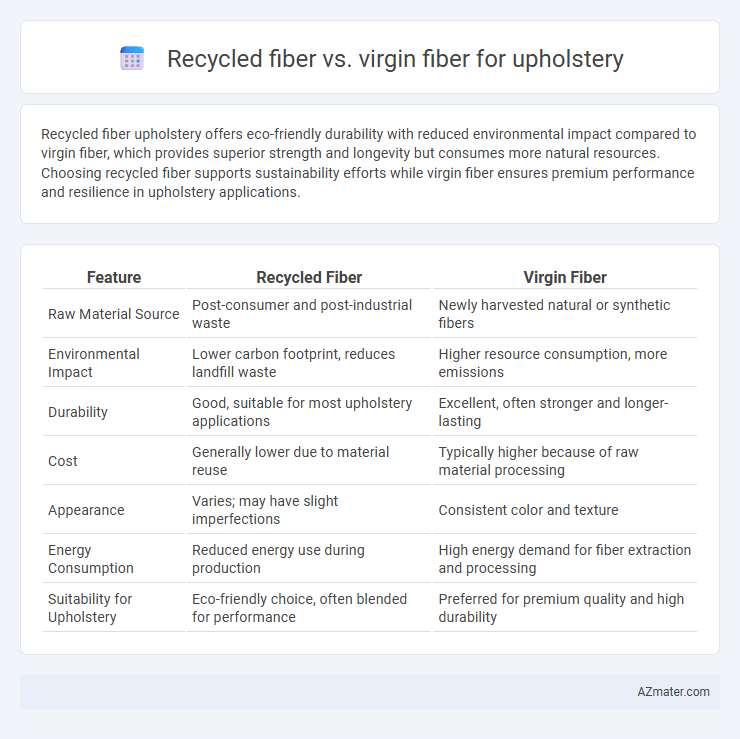Recycled fiber upholstery offers eco-friendly durability with reduced environmental impact compared to virgin fiber, which provides superior strength and longevity but consumes more natural resources. Choosing recycled fiber supports sustainability efforts while virgin fiber ensures premium performance and resilience in upholstery applications.
Table of Comparison
| Feature | Recycled Fiber | Virgin Fiber |
|---|---|---|
| Raw Material Source | Post-consumer and post-industrial waste | Newly harvested natural or synthetic fibers |
| Environmental Impact | Lower carbon footprint, reduces landfill waste | Higher resource consumption, more emissions |
| Durability | Good, suitable for most upholstery applications | Excellent, often stronger and longer-lasting |
| Cost | Generally lower due to material reuse | Typically higher because of raw material processing |
| Appearance | Varies; may have slight imperfections | Consistent color and texture |
| Energy Consumption | Reduced energy use during production | High energy demand for fiber extraction and processing |
| Suitability for Upholstery | Eco-friendly choice, often blended for performance | Preferred for premium quality and high durability |
Introduction to Upholstery Fibers
Recycled fiber in upholstery offers an eco-friendly alternative by utilizing post-consumer or post-industrial materials, reducing landfill waste and conserving natural resources. Virgin fiber, derived directly from raw materials such as cotton, wool, or synthetic polymers, provides unmatched strength and durability critical for high-quality upholstery applications. Selecting between recycled and virgin fibers depends on balancing sustainability goals with performance requirements in upholstery projects.
Understanding Recycled Fiber
Recycled fiber in upholstery is derived from post-consumer or post-industrial waste, reducing environmental impact by minimizing the demand for virgin raw materials like wood pulp or synthetic polymers. This sustainable alternative often retains comparable durability and comfort levels to virgin fiber, making it suitable for various furniture applications while lowering carbon footprint and water consumption during production. Understanding the source and processing of recycled fibers helps consumers and manufacturers make informed decisions prioritizing eco-friendly upholstery without compromising quality.
What is Virgin Fiber?
Virgin fiber refers to textile fibers that are produced directly from natural sources such as trees or plants, without any previous processing or recycling. In upholstery, virgin fiber offers superior strength, durability, and uniformity, making it ideal for high-quality furniture that demands longevity and resilience. Unlike recycled fiber, virgin fiber maintains consistent texture and color, contributing to a premium appearance and enhanced fabric performance.
Environmental Impact: Recycled vs Virgin Fiber
Recycled fiber used in upholstery significantly reduces environmental impact by lowering energy consumption and decreasing landfill waste compared to virgin fiber production, which involves extensive resource extraction and higher carbon emissions. The manufacturing process of recycled fibers also minimizes water usage and toxic chemical release, fostering a more sustainable lifecycle. Choosing recycled fiber supports circular economy principles without compromising upholstery quality, promoting eco-friendly interior solutions.
Durability and Longevity Comparison
Recycled fiber upholstery often offers comparable durability to virgin fiber, with advancements in processing enhancing strength and resistance to wear. Virgin fiber typically provides superior longevity due to its natural fiber integrity and fewer prior stress factors. Both materials benefit from treatments and fabric blends that improve their lifespan in high-traffic applications.
Cost Analysis: Which Fiber is More Affordable?
Recycled fiber for upholstery generally offers a more affordable option compared to virgin fiber due to lower raw material costs and reduced energy consumption during production. Virgin fiber exhibits higher prices as it requires fresh resources and more intensive manufacturing processes, increasing overall expenses. Cost-conscious buyers often prefer recycled fiber for budget-friendly upholstery projects without compromising quality.
Aesthetics and Texture Differences
Recycled fiber upholstery often has a slightly coarser texture compared to the smooth and uniform feel of virgin fiber, affecting the overall tactile experience. Virgin fibers provide richer color depth and a more consistent appearance, enhancing the aesthetic appeal of high-end furniture. While recycled fibers contribute to eco-friendly choices, virgin fibers excel in delivering superior softness and visual refinement for upholstery.
Maintenance and Cleaning Requirements
Recycled fiber upholstery demands more frequent and gentle cleaning due to its lower resistance to abrasion and moisture compared to virgin fiber, which offers enhanced durability and stain resistance. Virgin fiber fabrics typically withstand harsher cleaning agents and higher temperatures, making them easier to maintain and prolonging their lifespan in high-traffic areas. Choosing virgin fiber reduces the risk of fiber degradation during routine maintenance, ensuring sustained upholstery appearance and performance.
Sustainability Considerations in Upholstery
Recycled fiber significantly reduces the environmental footprint of upholstery by lowering water consumption, energy usage, and landfill waste compared to virgin fiber production. Virgin fibers, while often providing greater durability and texture, require intensive resource extraction, contributing to deforestation and greenhouse gas emissions. Choosing recycled fiber upholstery supports circular economy principles and aligns with sustainable design goals by minimizing environmental impact throughout the product lifecycle.
Choosing the Right Fiber for Your Upholstery Needs
Recycled fiber offers a sustainable and cost-effective option for upholstery, providing durability while reducing environmental impact by reusing materials like post-consumer polyester and cotton blends. Virgin fiber, made from newly sourced materials such as natural wool or synthetic nylon, delivers superior strength and resilience, ideal for high-traffic furniture requiring long-lasting wear. Selecting the right fiber depends on factors like budget, desired texture, durability requirements, and environmental considerations to ensure the best performance and upholstery lifespan.

Infographic: Recycled fiber vs Virgin fiber for Upholstery
 azmater.com
azmater.com